Training, multi-agency partnership inspire over 100 Idaho ranchers to engage in range monitoring
More Idaho ranchers are getting involved in range monitoring than ever before.
Ranchers understand that it’s important to document rangeland conditions on a consistent basis and provide the Bureau of Land Management with relevant data on rangeland health. But many of them didn’t necessarily know how to monitor rangelands effectively until a new program came along to provide education, field training and BLM protocols to follow.
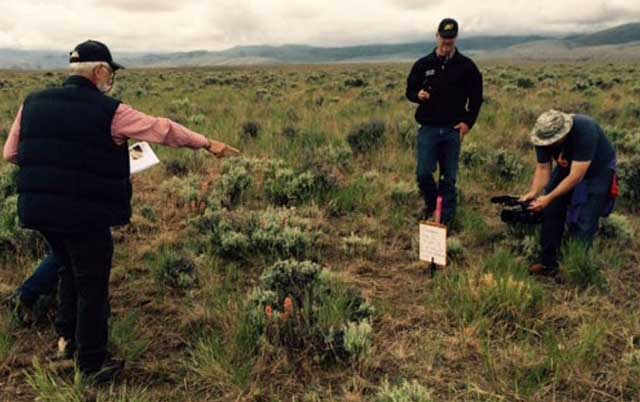
A group of ranchers work together to set up a landscape photograph at a BLM photo point during a range monitoring workshop in Oreana while Life on the Range videographer Chris Ennis documents the story.
Tony and Brenda Richards, who run cattle in the Owyhee Mountains, are two of more than 100 ranchers in southern Idaho who are jumping on board this year.
“We look at this as an investment in keeping our business healthy and thriving, and keeping the resource healthy and thriving,” said Brenda Richards, who also chairs the Owyhee Ini-tiative Committee and is president of the national Public Lands Council.
Jason Nettleton, who also ranches in the Owyhees, says it’s great to put more attention on range monitoring and management. “I think every rancher does that as a steward of the land. First, and foremost, I don’t consider myself a rancher. I consider myself as a vegetation monitor because really, we’re not raising cows, we’re raising grass. We use the cows to harvest that.
“We would like to certainly be a little more accountable for what we’re doing and know what impacts that we’re having on the range as well as being able to be one step ahead of the game in case we do see some issues that arise.”
The new range monitoring program is a cooperative effort by the Idaho State Department of Agriculture, the Bureau of Land Management, University of Idaho Extension Service, University of Idaho Rangeland Center, and the Idaho Rangeland Resource Commission. A Memorandum of Understanding between ISDA and the BLM sets the protocols on how to gather monitoring data so the information is readily accepted by the BLM.
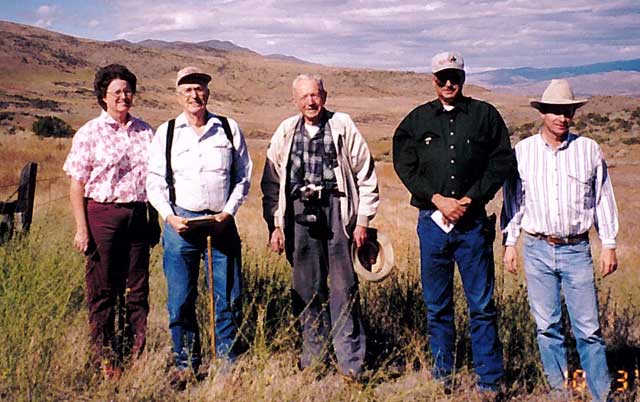
Gus Hormay, center, worked with the Little family to set up photo-monitoring points on their ranch as part of a rest-rotation grazing system. From left, Judy Hinman, David Little, Hormay, Jim Little and Brad Little. “It is a gift to the future,” Jim Little says.
Under the new program, 27 photo points were taken on 125,000 acres of public rangeland in 2014. This year, at least 135 photo points are being taken on 300,000 acres of public rangeland.
Amanda Gearhart taught 14 range-monitoring educational workshops across southern Idaho last spring, from Idaho Falls to Marsing. About 100 ranchers attended, plus an equal number of BLM, Forest Service and Idaho Department of Lands employees. The workshops feature classroom and field sessions to teach people how to gather photo and plant monitoring data.
University of Idaho extension professionals across southern Idaho helped publicize the workshops to increase participation. “I just think it’s a great program,” said Scott Jensen, University of Idaho Extension Educator in Owyhee County. “It provides ranchers with the tools they need to collect data – not only collect it, but have credible data so they can have that included in their allotment files and utilized in the whole decision-making process.”
Then, as a follow up, experts from Idaho State Department of Agriculture help ranchers get started with photo-monitoring on a one-to-one basis in the field, using the protocols agreed upon by the BLM and ISDA.
“I don’t think it’s too early to say this is working,” says Gretchen Hyde, executive director of the Idaho Rangeland Resource Commission. “I think Idaho is a leader on this. That’s really awesome.”
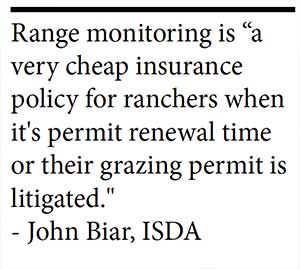
Range Land Quote
Hyde grew up on a ranch in Emmett, where range monitoring photo points were set up long ago. “Back in the 70s, my grandfather worked with Gus Hormay to set up a rest-rotation system, and at the same time, a monitoring program,” Hyde explains. “Over the years, having that data, having those photos, we were able to impact some of the decision-making, because we knew more about how things were being impacted in a positive way.
“My dad always said that it’s a gift to the future. And having that data will be beneficial in the long term. “Healthy lands equal healthy livestock. It’s important for them to share the data and work together on that.”
A key advantage for ranchers to get involved is that the data they gather will supplement existing photo data and notes in BLM files. MOU protocols call for photo-monitoring data to be collected in the same location at the same time each year for continuity. BLM photo points already have been established in most areas.
John Biar, who recently retired from ISDA, was a key partner in creating the new range monitoring program.
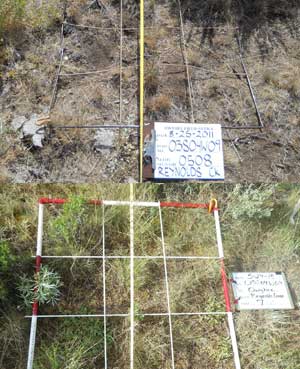
The range monitoring protocols call for using a 3-foot by 3-foot frame to collect information about range plants growing inside the frame.
“What we wanted to do was find a tool that we could help the federal agencies with, in getting good monitoring data that would support the BLM and help in grazing permit renewal decisions,” Biar said.
“Monitoring is important, I believe, because it’s going to be the future of rangeland management in Idaho. The federal agencies are very shorthanded due to budget reductions, their work loads are very significant, and they have more litigation than they’ve had in the past. They are our partners in land management.”
Nika Lepak, a Rangeland Management Specialist in the BLM State Office, said, “The MOU is valuable for BLM because we know that when a permittee is working with ISDA that they’re following all the correct protocols for completing photo monitoring, and we know that they’re doing that work over the lifespan of the grazing permit.
“And we also know they’ll be submitting those photos on a regular basis.”
Adds Biar, “For BLM, it gives them consistent, year to year, photo monitoring data. What that does, is captures the good years, the dry years, it captures everything that happens at these key sites going on out there. For the rancher, it helps the rancher keep and have their own data. They will have data that supports their ranching operation, their grazing management systems. It’s a very cheap insurance policy for them when it’s permit renewal time or their grazing permit is litigated.”
The range monitoring workshops explain the BLM protocols in the classroom and the field. But before Amanda Gearhart goes into that detail, she explains what range monitoring is, and why it’s important at a workshop in Oreana in Owyhee County.
“Monitoring is defined as the orderly, repeated collection, analysis and interpretation of resource information. It is designed to detect change over time,” she says.
Indeed, photo monitoring tells a story about the land over time. It also shows how changing weather conditions or livestock management may affect the land over time. Owyhee County Rancher Tony Richards sees a lot of value in documenting those changes.
“From my point of view, it’s really important that I know what my management is doing,” Richards says. “We have different kinds of years, from wet years to dry years. The long term will tell what’s going on more accurately. I think when it comes to this permit renewal, that’s the kind of information you have to have to truly know what’s going with your allotment.”
The BLM protocols require the following information to be collected:
- Take landscape photos from existing BLM photo points from several different directions.
- Fill out a photo board with pertinent information prior to taking the landscape photos.
- Place a 3-foot-square frame on the ground, and take a close-up photo of the vegetation in the frame.
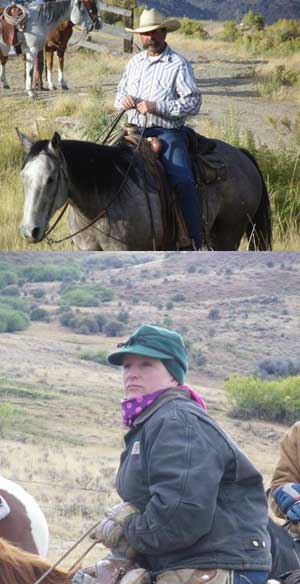
Tony Richards, top, and Brenda Richards above, both say that range monitoring is important to track management goals and how grazing is affecting the land over time.
Locating the existing BLM photo points can be most challenging, even with the GPS coordinates. At the Oreana field workshop, several groups had difficulty finding BLM yellow or orange markers on the ground in a sea of sagebrush. But once they found the spot, they set up the photo monitoring picture. They used previous BLM monitoring photos to orient the photo in the same direction.
ISDA Rangeland Specialist Brooke Jacobson explains what information should be on the photo board to meet BLM protocol. “It has the date, and the site name, the field office, the allotment and the pasture. Other information you can include is the direction the photo is taken, the GPS location.”
Upon request, Jacobson goes out and assists ranchers in gathering monitoring data for the first time on BLM grazing allotments to walk them through the process. She’s been working with Tony and Brenda Richards to get their field work completed.
“The key to the program here in Idaho, there’s several other states that have monitoring programs, DVD’s or books or information out there, but it’s a little intimidating,” Richards says. “But the beauty about this goes back to the partnership is there, and the simplicity within that partnership, but still getting the protocol that’s going to be acceptable to get that data into your file.”
Being able to contribute to the BLM’s files on range conditions is another key benefit. The MOU encourages ranchers to check out the files and contribute data on a regular basis. ”
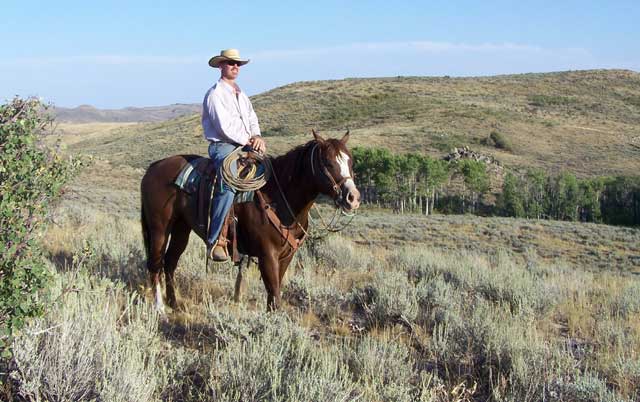
Jason Nettleton pauses to enjoy the view while working cattle in the Owyhees. He attended the Oreana work-shop to learn about the BLM-ISDA range monitoring protocols. (photo courtesy Jason Nettleton)
“It’s kind of a good place to crack the door, come in, go through their files, and see what’s in there, and understand how it relates to the conditions on their grazing allotment,” says Nika Lepak.
“It’s going to be beneficial to the BLM because they have a tremendous workload,” Brenda Richards says. “So with this program, it’s a true partnership that is actually something on the ground, helping the resource and the businesses out here.
“The habitat is the way it is — one of the key components is properly managed grazing — and keeping those plant communities that way. With the training, that will only make things better.”
Steve Stuebner is the writer and producer of Life on the Range, a public education project sponsored by the Idaho Rangeland Resource Commission.
© Idaho Rangeland Resources Commission, 2015

